




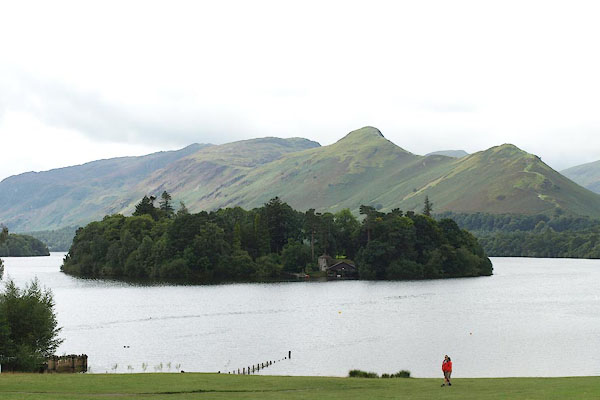
BPP94.jpg From Crow Park; Catbells behind.
(taken 24.8.2008)
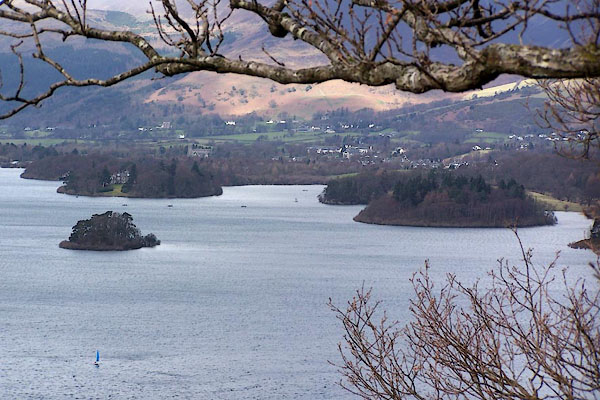
BLT86.jpg From Lowcrag Wood.
(taken 3.4.2006)
placename:- Derwent Isle
placename:- Darwen Insul
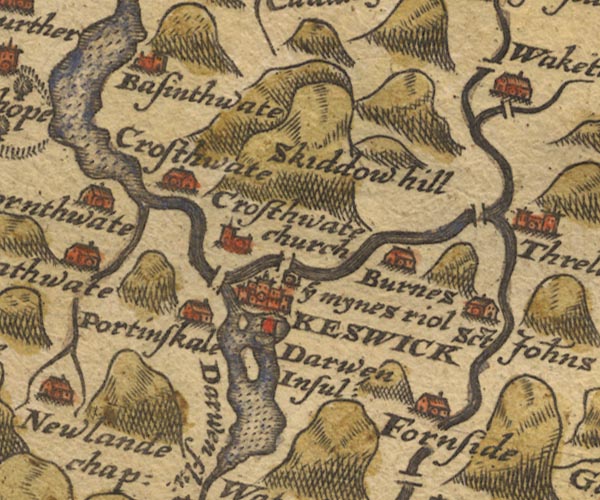
Sax9NY22.jpg
"Darwen Insul"
With a small building.
item:- private collection : 2
Image © see bottom of page
placename:- Darwen Iland
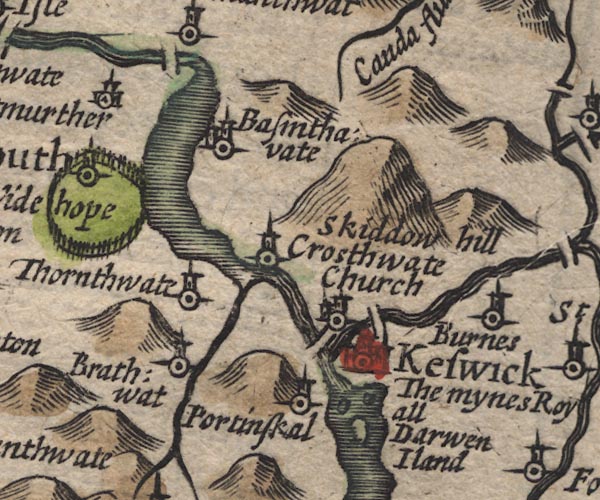
SP11NY22.jpg
"Darwen Iland"
island in Derwent Water
item:- private collection : 16
Image © see bottom of page
placename:- Darwent Island
item:- mines; copper mines; Company of Mines Royal; gold; silver
 goto source
goto sourcepage 165:- "... Darwent ...
Doth quickly cast her selfe into an ample Lake,
And with Thurls mighty Mere, betweene them two doe make
An Island, which the name from Darwent doth derive,
Within whose secret breast nice nature doth contrive,
That mighty Copper Myne, which not without its Vaines,
Of Gold and Silver found, it happily obtaines
Of Royaltie the name, the richest of them all
That Britan bringeth forth, which Royall she doth call."
placename:- Darwen Island
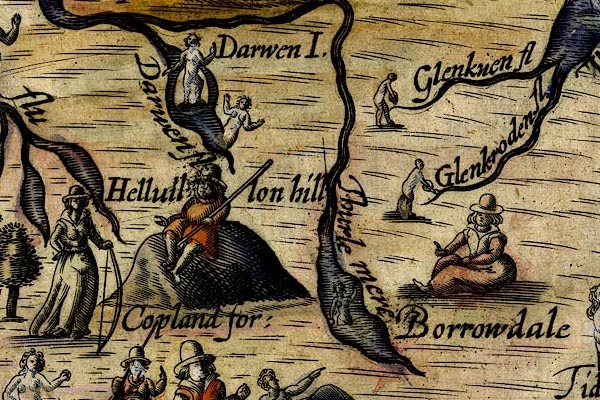
DRY514.jpg
"Darwen I."
Island, naiad by the island.
item:- JandMN : 168
Image © see bottom of page
placename:- Darwen Iland
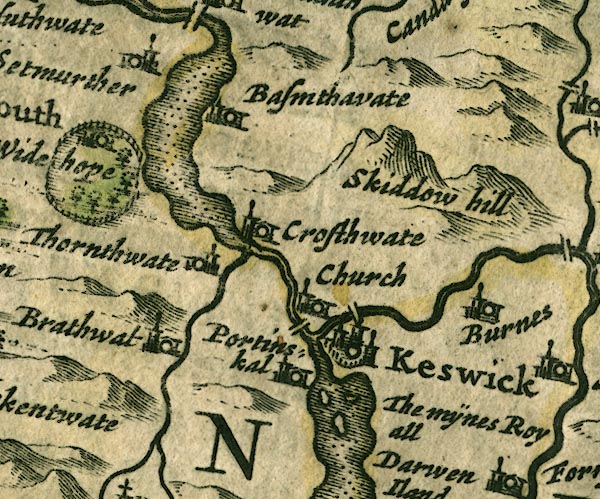
JAN3NY22.jpg
"The mÿnes Royall / Darwen Iland"
The label is alongside the lake, where the miners from Germany settled on the island.
item:- JandMN : 88
Image © see bottom of page
placename:- Darwen Iland
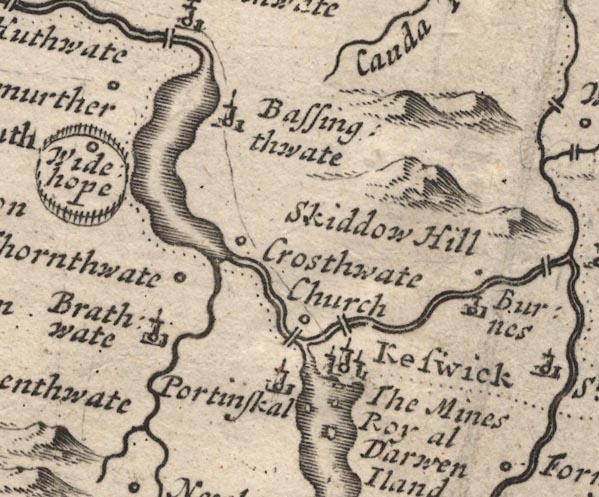
MD12NY22.jpg
"The Mines Royal / Darwen Iland"
Island; the miners from Germany settled on the island.
item:- JandMN : 90
Image © see bottom of page
 goto source
goto source"..."
"... in which [Derwent Water] there are three Islands, one of them inhabited by German Miners; ..."
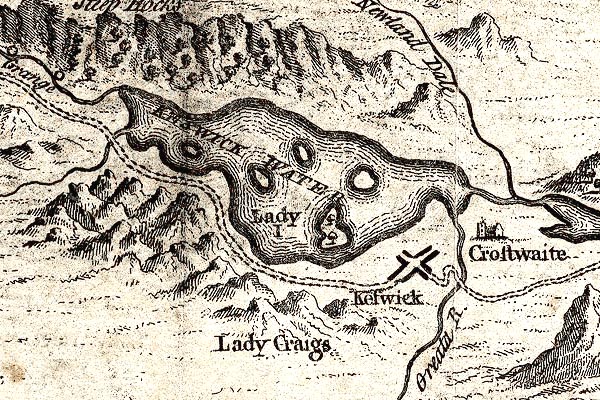
GM1311.jpg
island
item:- JandMN : 114
Image © see bottom of page
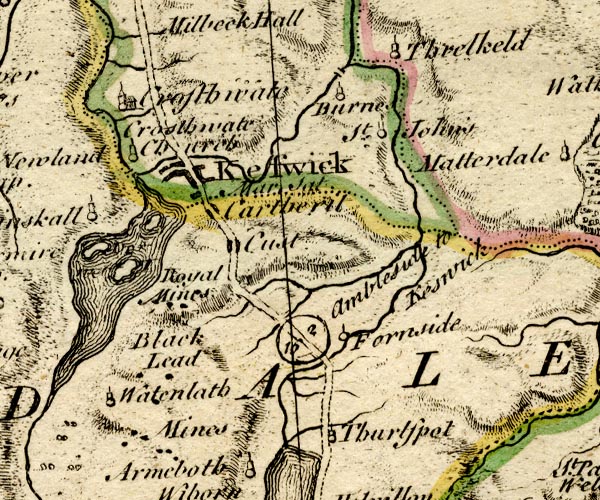
BO18NY21.jpg
"Royal Mines"
in Derwent Water, labelled on shore by the wrong island, Lord's Island; Derwent Isle was the base of the german miners.
item:- Armitt Library : 2008.14.10
Image © see bottom of page
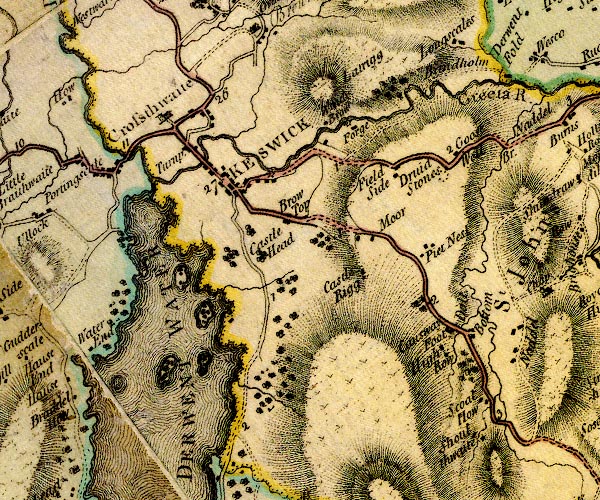
D4NY22SE.jpg
island in Derwent Water
item:- Carlisle Library : Map 2
Image © Carlisle Library
placename:- Vicar's Isle
placename:- Vicar's Island
 goto source
goto sourcePage 90:- "[Derwent Water] ... Vicar's-isle rises in beautiful and circular form; ..."
"..."
 goto source
goto sourcePage 111:- "... and a third [island] with a hut upon it, stript of its ornamental trees by the unfeeling hand of avarice [1]. ..."
"[1] This third is Vicar's island, which has since been purchased by a gentleman, who has built a large mansion, and made some other improvements upon it."
 goto source
goto sourceAddendum; Mr Gray's Journal, 1769
Page 208:- "..."
"[2] It is somewhat extraordinary that Mr. Gray omitted to mention the islands on Derwent-water, one of which, I think they call it Vicar's island, makes a principal object in the scene. See Smith's view of Derwent-water."
placename:- Pocklington's Island
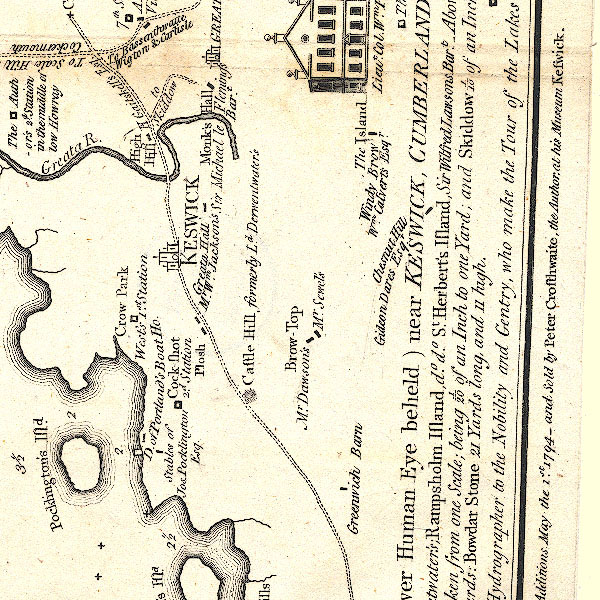
CT2NY22Q.jpg
"Pocklington's Isld."
In the map title:- "Pocklington's Island is the property of Lieut. Col Peachy"
item:- Armitt Library : 1959.191.3
Image © see bottom of page
placename:- Pocklington's Island
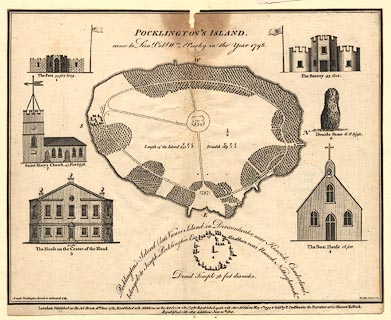 click to enlarge
click to enlargeCT03.jpg
item:- Armitt Library : 1959.191.6
Image © see bottom of page
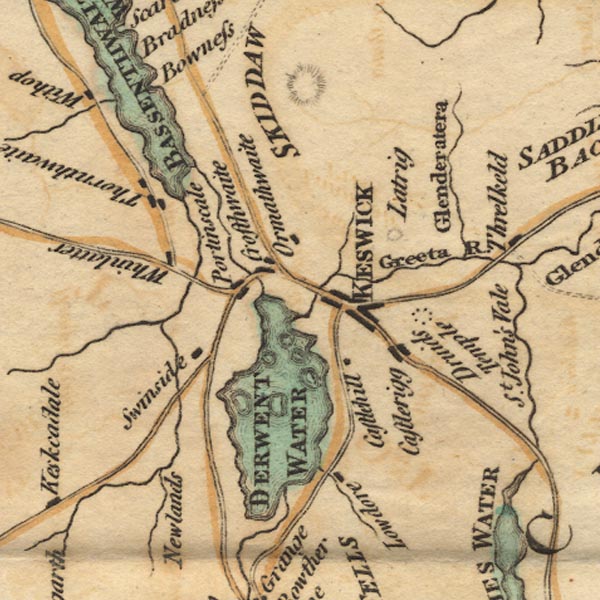
Ws02NY22.jpg
item:- Armitt Library : A1221.1
Image © see bottom of page
placename:- Vicars Island
 goto source
goto source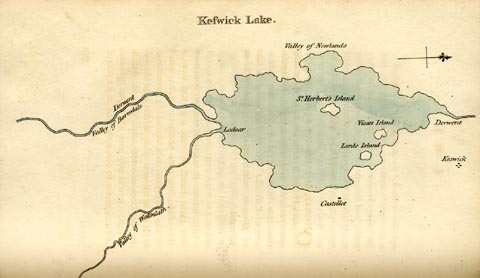 click to enlarge
click to enlargeGLP312.jpg
Plate vol 1 opposite p.179 in Observations on Picturesque Beauty published by T Cadell and W Davies, Strand, London, 1808.
caption from the list of plates:- "This plan of Keswick-lake means only to express the general shape of it; and the relative situation of it's several parts."
item:- Armitt Library : A918.12
Image © see bottom of page
placename:- Vicar's Island
 goto source
goto sourcevol.1 p.180 "The lake of Derwent, or Keswick-lake, as it is generally called, is contained within a circumference of about ten miles; presenting itself in a circular form, tho in fact it is rather oblong. It's area is interspersed with four or five islands; three of which only are of consequence, Lord's island, Vicar's island, and St. Herbert's island: but none of them is comparable to the island on Windermere, in point either of size, or beauty."
 goto source
goto sourcevol.1 p.184 "..."
"To the formality of it's shores may be added the formality of it's islands. They are round, regular, and similar spots, as they appear from most points of view; formal in their situation, as well as in their shape; and of little advantage to the scene. ..."
placename:- Vicar's Island
placename:- Pocklington' Island
item:- fort; druidical temple
 goto source
goto sourcePage 84:- "... Vicar's Island, now called, (from its proprietor) Pocklington's Island. This is one of the largest, and is beautifully ornamented by its spirited owner. On the western side he has built a fort, on which he has a battery, as before mentioned: on the South side of the fort is a druidical temple, exactly facing Keswick; and close to the shore is the appearance of a chapel, which consists of only one wall and a steeple: the steeple contains a room, not furnished with bells, but good roast-beef and claret; where the worthy Proprietor very facetiously said he might, he thought, always find more priests ready to attend, than at their own churches by the tinkling of bells. ..."
placename:- Vicars Island
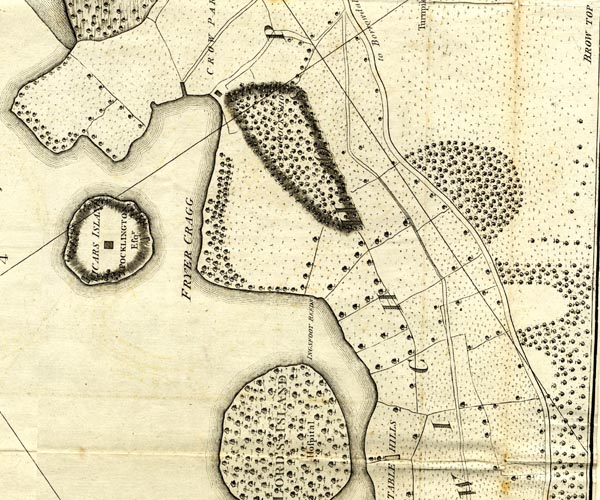
CL152622.jpg
"VICARS ISLAND / POCKLINGTON Esqr."
island, buildings
item:- private collection : 169
Image © see bottom of page
placename:- Vicar Isle
 goto source
goto sourcePage 182:- "..."
""... Vicar isle full of trees like a wilderness.""
 goto source
goto sourceGentleman's Magazine 1805 p.1121 "... On the most considerable of this little archipelago [islands in Derwent Water] stands a tasteless mansion, the residence of a gentleman whose splendid regattas have acquired him an extensive celebrity in the county. ..."
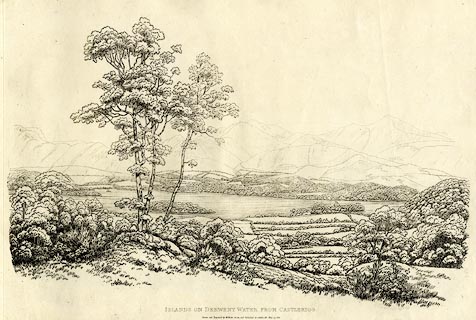 click to enlarge
click to enlargeGN1231.jpg
From near right to far - Derwent Isle, Lord's Island, St Herbert's Island?
Plate 31 in Sixty Studies from Nature, 1810.
printed at top right:- "31"
printed at bottom:- "ISLANDS ON DERWENT WATER FROM CASTLERIGG. / Drawn and Engraved by William Green, and Published at Ambleside, June 24, 1810."
watermark:- "J WHATMAN / 1813"
item:- Armitt Library : A6641.31
Image © see bottom of page
placename:- Vicar's Island
 goto source
goto sourcepage 62 "... At the bidding of an alien improver, the Hind's Cottage, upon Vicar's island, ... with its embowering sycamores and cattle-shed, disappeared from the corner where they stood; and right in the middle, and upon the precise point of the island's highest elevation, rose a tall square habitation, with four sides exposed, like an astronomer's observatory, or a warren-house reared upon an eminence for the detection of depredators, or, like the temple of OEolus, where all the winds pay him obeisance. Round this novel structure, but at a respectful distance, platoons of firs were stationed, as if to protect their commander when weather and time should somewhat have shattered his strength. Within the narrow limits of this island were typified also the state and strength of a kingdom, and its religion as it had been, and was, - for neither was the druidical circle"
 goto source
goto sourcepage 63 "uncreated, nor the church of the present essablishment (sic); nor the stately pier, emblem of commerce and navigation; nor the fort to deal out thunder upon the approaching invader. The taste of a succeeding proprietor rectified the mistakes as far as was practicable, and has ridded the spot of its puerilities. The church, after having been docked of its steeple, is applied both ostensibly and really, to the purpose for which the body of the pile was actually erected, namely a boat-house; the fort is demolished; and, without indignation on the part of the spirits of the ancient Druids who officiated at the circle upon the opposite hill, the mimic arrangement of stones, with its sanctum sanctorum, has been swept away."
"The present instance has been singled out, extravagant as it is, because, unquestionably, this beautiful country has, in numerous other places, suffered from the same spirit, though not clothed exactly in the same form, nor active in an equal degree. ..."
placename:- Vicar's Island
placename:- Pocklington's Island
 goto source
goto sourcepage 17:- "... Vicar's Island (late Pocklington's Island), ..."
placename:- Derwent Isle
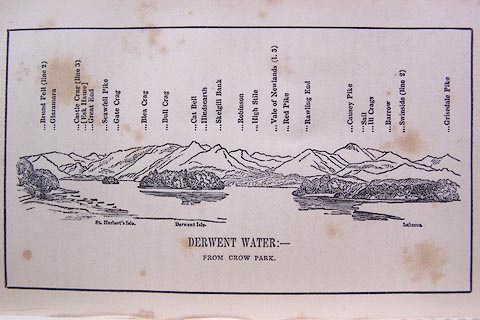 click to enlarge
click to enlargeO80E06.jpg
item:- Armitt Library : A1180.7
Image © see bottom of page
placename:- Vicar's Isle
placename:- Pocklington's Island
item:- garden
 goto source
goto sourcePage 17:- "The Vicar's Isle, belonging to General Peachy, contains about six acres, beautifully laid out in"
 goto source
goto sourcePage 18:- "pleasure grounds, interspersed with a variety of trees, and crowned with a house in the centre. For some years it was called Pocklington's Island, while it belonged to a gentleman of that name; and is sometimes by way of pre-eminence called Derwent Isle. ..."
"..."
 goto source
goto sourcePage 119:- "... Vicar's Isle, on which General Peachy has a house."
 goto source
goto sourcePage 120:- "... Coming in sight of the lake, Vicar's Isle is most happily placed, the house just appearing among a variety of forest trees with which the island seems wholly covered; but on inspection, it is found to be beautifully laid out in pleasure grounds, and kept in the neatest order. ..."
placename:- Vicar's Island
 goto source
goto sourcePage 54:- "... The Vicar's Island, in olden times pertaining to Fountain's Abbey, now belonging to General Peachy, is beautifully laid out in pleasure-grounds, and crowned with a neat mansion, nearly hid amidst the variety of trees, having a view to the south only. ..."
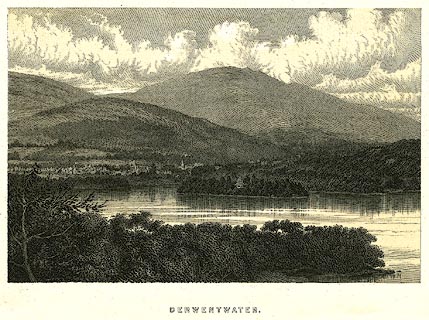 click to enlarge
click to enlargePR0274.jpg
Derwent Isle and its house in the midground.
printed at bottom:- "DERWENTWATER."
item:- Dove Cottage : 2008.107.274
Image © see bottom of page
placename:- Derwent Isle
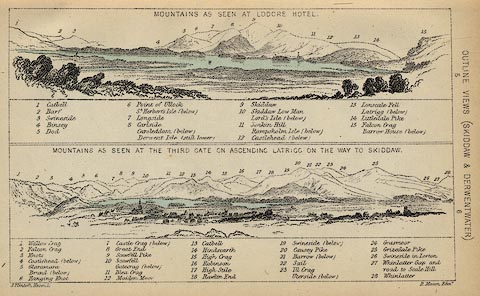 click to enlarge
click to enlargeBC08E4.jpg
"... Derwent Isle ..."
item:- JandMN : 37.14
Image © see bottom of page
placename:- Derwent Isle
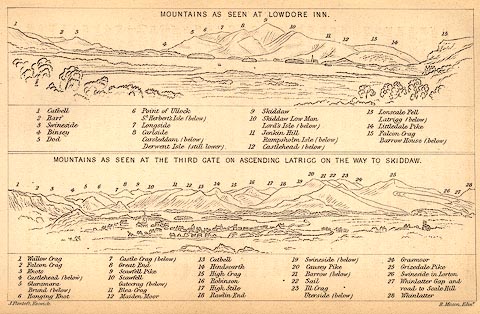 click to enlarge
click to enlargeBC02E4.jpg
"... Derwent Isle ..."
item:- JandMN : 32.7
Image © see bottom of page
placename:- Vicar's Isle
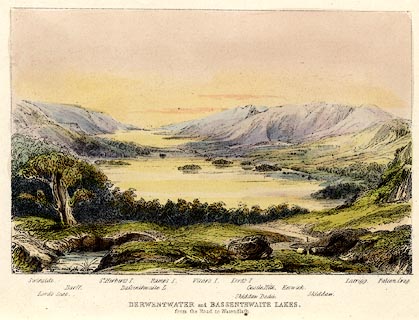 click to enlarge
click to enlargeTAT212.jpg
Included in The Lakes of England, by W F Topham.
printed at bottom:- "DERWENTWATER and BASSENTHWAITE LAKES, / from the road to Watendlath."
printed at bottom:- "Swinside. / Lord's Seat. / Barff. / St. Herbert's I. / Bassenthwaite L. / Ramps I. / Vicar's I. / Lord's I. / Skiddaw Dodd. / Castle Hill. / Keswick. / Skiddaw. / Latrigg. / Falcon Crag."
item:- Armitt Library : A1067.12
Image © see bottom of page
placename:- Vicar's Isle
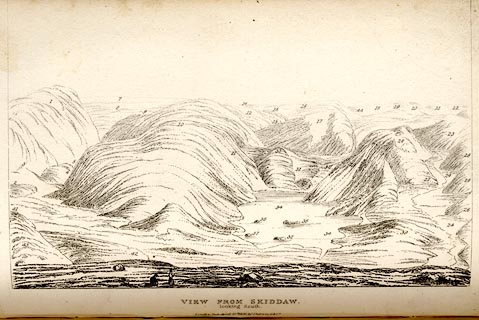 click to enlarge
click to enlargeTAT137.jpg
The print is captioned with mountain names and acts as an outline view.
Tipped in opposite p.91 of The Lakes of England, by George Tattersall.
printed at bottom:- "VIEW FROM SKIDDAW, / looking South. / [London Pubd. ...]"
printed at p.91:- "... FOUR VIEWS FROM THE SUMMIT OF SKIDDAW. III. LOOKING SOUTH. / ... / 38. Vicar's Ilse, Derwentwater. / ..."
item:- Armitt Library : A1204.38
Image © see bottom of page
placename:- Vicar's Isle
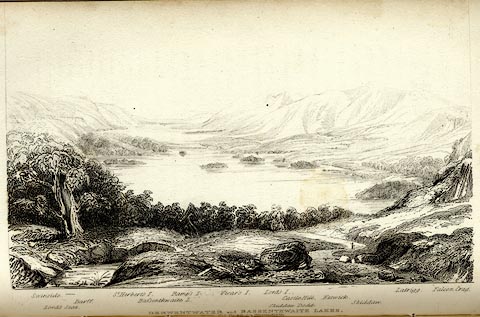 click to enlarge
click to enlargeTAT130.jpg
The print is captioned with mountain names and acts as an outline view.
Tipped in opposite p.77 of The Lakes of England, by George Tattersall.
printed at bottom:- "DERWENTWATER and BASSENTHWAITE LAKES, / from the road to Watendlath."
printed at bottom left to right:- "Swinside. / Lord's Seat. / Barff. / St. Herbert's I. / Bassenthwaite L. / Ramp's I. / Vicar's I. / Lord's I. / Skiddaw Dodd. / Castle Hill. / Keswick. / Skiddaw. / Latrigg. / Falcon Crag."
item:- Armitt Library : A1204.31
Image © see bottom of page
placename:- Vicar's Island
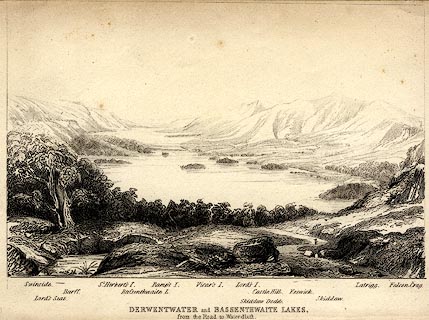 click to enlarge
click to enlargePR0370.jpg
The view is from just above Ashness Bridge. Objects in the view are identified by a caption at the bottom (unfortunately the print is pale, so some objects are unclear, and the caption seems to be a little misaligned) - Swinside, Lord's Seat, Barff, St. Herbert's I., Bassenthwaite L., Ramp's I., Vicar's I., Lord's I., Skiddaw Dodd, Castle Hill, Keswick, Skiddaw, Latrigg, Falcon Crag.
printed at bottom:- "DERWENTWATER and BASSENTHWAITE LAKES. / from the Road to Watendlath."
item:- Dove Cottage : 2008.107.370
Image © see bottom of page
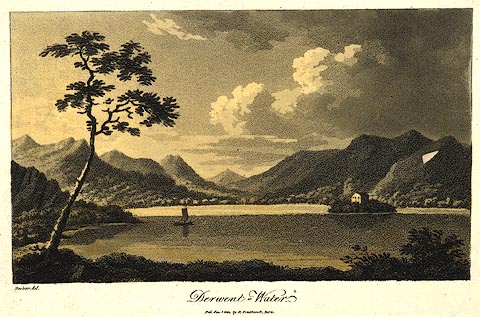 click to enlarge
click to enlargePR0438.jpg
Derwent Isle and its house in the midground.
A companion print has the publisher as Cruttwell.
printed at bottom left, centre:- "Becker del. / Derwent-Water. / Pub. Jan. 1 1802, by R. Crutterell, Bath."
item:- private collection : 102
Image © see bottom of page
placename:- Pocklington's Island
item:- boat; rowing boat; landing stage; house
item:- Pocklington
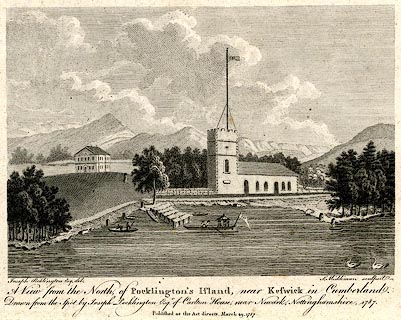 click to enlarge
click to enlargePR0536.jpg
Included in The History of the County of Cumberland, by William Hutchinson, published by Law and Son, Clarke, and Taylor, London, 1794.
printed at bottom:- "Joseph Pocklington Esq. del. S. Middiman sculpsit. / A View from the North, of Pocklington's Island, near Keswick in Cumberland. / Drawn from the Spot by Joseph Pocklington Esqr. of Carlton House, near Newark, Nottinghamshire. 1786. / Published as the Act directs, March 29, 1787."
item:- Dove Cottage : 2008.107.485
Image © see bottom of page
placename:- Derwent Isle
placename:- Pocklington's Island
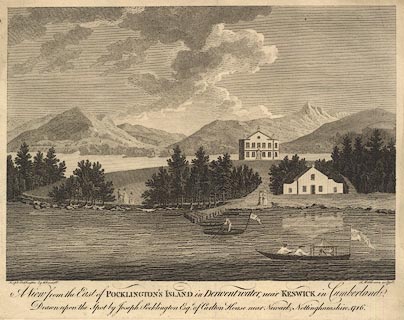 click to enlarge
click to enlargeBMZ91.jpg
item:- Dove Cottage : Lowther.55
Image © see bottom of page
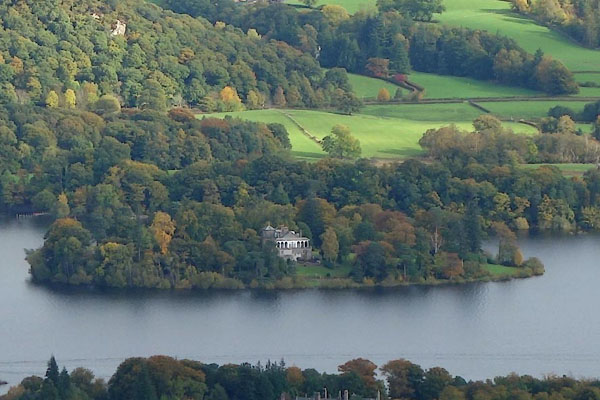
BZO07.jpg (taken 24.10.2013)
